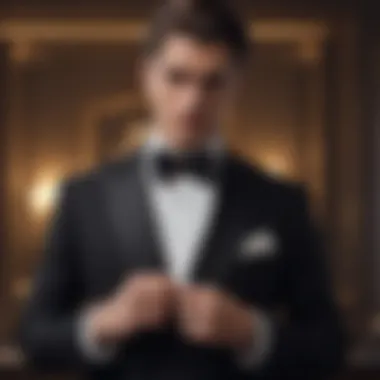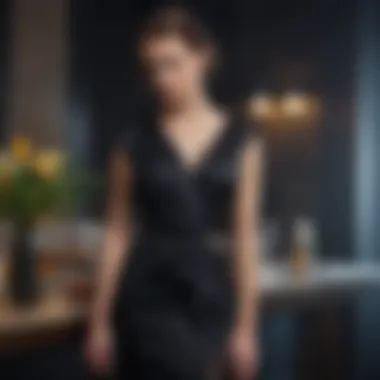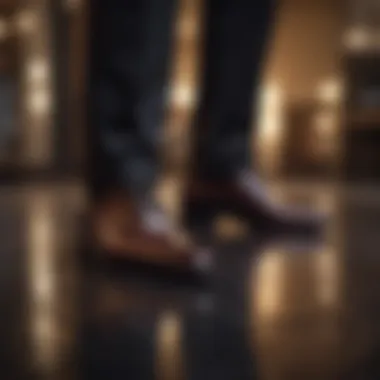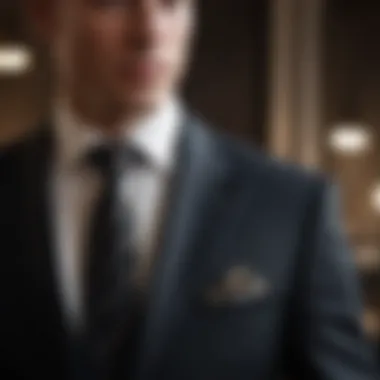Mastering Attire for a Black Tie Optional Wedding


Intro
Attending a black tie optional wedding can feel like juggling a dozen different things at once. You want to impress without going overboard. Finding the sweet spot between formal and relaxed is a tightrope walk many face when invited to such an event. These gatherings let you express your personal style while adhering to a dress code that doesn't scream for attention but seeks subtle sophistication.
Understanding the nuances of black tie optional attire is vital. This attire type may sound straightforward, but it carries layers of meaning that can trip up even the most seasoned event-goers. Think of it as an ongoing conversation between the classic and the contemporary. The objective is to strike a balance where you don’t feel too rigid, yet you also don’t overshadow the couple’s special day.
Let’s take a closer look at how to navigate this sartorial spectrum, offering guidance on making choices that reflect not just current trends, but also your unique personality. This is more than just about choosing a nice suit or a shirt—it’s about creating an impression that resonates for years to come, perhaps even sparking discussions long after the night has passed.
Thus, we'll delve into haircuts that resonate with the contemporary gentleman, highlight must-have pieces that can amp up your look, and share some useful style tips to ensure you're appropriately dressed for the occasion. Let’s embark on this journey together, steering through the waters of attire choices with finesse.
Understanding Black Tie Optional
The phrase "black tie optional" can sometimes stir confusion among guests invited to a wedding. It's a blend of sartorial elegance and individual expression. This section dives into the essence of this dress code, illuminating its intricate layers and considerations that can guide attendees on their fashion choices. A deep understanding of this topic not only helps one dress appropriately but also plays a significant role in how one expresses personal style in a formal setting.
The Definition of Black Tie Optional
Black tie optional essentially allows guests the flexibility to opt for either a tuxedo or a more casual suit. Picture the vibe at a wedding where everyone is dressed to the nines. The beauty of the "optional" designation is that it acknowledges diverse tastes and comfort levels while still aiming for a polished and sophisticated look. For men, it means that a well-tailored, dark suit can work just as well as a triangle satin bow tie and a tuxedo jacket. This flexibility can be a double-edged sword; it empowers individuals to show their style but requires careful thought to avoid the pitfall of being underdressed in a sea of formal wear.
Historical Background
Tracing the origins of black tie leads us back to the 19th century. Formal evening dress took shape with certain styles gaining prominence amongst the elite. The "tuxedo" itself emerged as a more relaxed counterpart to the full tailcoat traditionally worn at such events. Over time, the cultural perceptions around what constituted formal attire evolved, leading to the black tie optional designation becoming a thing to accommodate varying social norms. In simpler terms, it reflects the shift in fashion away from rigid rules, emphasizing personal choice while still maintaining a level of decorum at social gatherings.
Distinctions from Other Dress Codes
Understanding how black tie optional differs from other dress codes is crucial. Here's a closer look:
- Black Tie: This requires a tuxedo, often with a bow tie, and usually a cummerbund or waistcoat. It's the highest form of formal wear, leaving little room for interpretation.
- Cocktail Attire: Here, the focus is on chic and stylish. A dark suit works well, but the formality can adjust based on the gathering's vibe. It's more laid-back compared to black tie optional.
- Formal Attire: A catch-all that can vary greatly in definition, from floor-length gowns to tuxedos.
Understanding these distinctions allows for more thoughtful preparation when dressing for the occasion. Attendees can feel secure in knowing they are making informed decisions that align with the expectations set by the couple hosting the event and, of course, their unique style.
Attire Guidelines for Guests
When it comes to a black tie optional wedding, choosing the right attire can feel like walking a tightrope. You want to come off as polished and sophisticated while still allowing room for personal flair. This segment will outline the essentials for both men and women, ensuring that you’re not just dressed appropriately but also confidently representing your style.
For Men: Traditional Choices
Tuxedos vs. Suits
The debate over tuxedos versus suits in a black tie optional context is one that every stylish man grapples with. Tuxedos tend to offer a level of formality that a suit simply can’t match. With that satin lapel and tailored fit, a tux asserts sophistication, making it a staple for more traditional interpretations of formal wear. On the flip side, a well-fitted suit can be just as dapper, especially if you’re trying to strike a balance between casual chic and elegant attire.
Opting for tuxedos could communicate that you respect the occasion, while choosing a suit might open the door to a more laid-back vibe. The key feature in this decision is recognizing the wedding's atmosphere.
However, if you do decide to wear a tux, remember that not all tuxedos are created equal—there's a difference between a rental and a bespoke piece, and that difference matters.
Color Schemes and Fabric Choices
Color plays an integral role in how one presents themselves at a wedding. In the realm of black tie optional, classic choices include shades like black, navy, or charcoal for suits, while tuxedos often lean towards black or midnight blue. However, the modern groom might choose to liven things up with rich jewel tones or lighter shades during summer.
Fabrics also come into play; linen is great for warm weather while wool remains a solid choice for colder months. Choosing the right material not only elevates the look but also dictates comfort and breathability. Remember, no one wants to be sweating bullets on the dance floor.
Accessories: The Final Touches
A well-chosen accessory can make or break an outfit. When it comes to black tie optional attire for men, accessories should complement, not overpower. Think classy: a silk tie or bow tie in a subtle pattern, a pocket square that matches either the tie or shirt, and maybe a pair of cufflinks that add just the right amount of bling without being ostentatious.
Shoes are also critical—oxfords or loafers in black leather are standard fare. One unique element worth considering is a sleek watch; it can indicate that you appreciate both function and style.
For Women: Options to Consider
Long vs. Short Dresses
When women attend a black tie optional wedding, their choice in dress length can communicate a lot. While long dresses project a formal air, shorter dresses can introduce a playful elegance. The traditional wisdom might lean toward longer hemlines for evening events, but this is slowly changing.


For example, a knee-length cocktail dress made from luxurious fabric can be just as appropriate, provided it’s styled correctly. The unique benefit of a short dress is its adaptability—you can easily dress it up or down with the right accessories. However, be wary of overly casual fabrics, which may send the wrong message.
Pant Suits and Jumpsuits
In recent years, pant suits and jumpsuits have emerged as fierce contenders in formal wear options. The perception of women’s formal attire is shifting, with tailored pants and stylish jumpsuits now offering a chic alternative to traditional dresses. They convey confidence and can be incredibly comfortable, particularly for those who prefer mobility.
What’s more, jumpsuits and well-fitted pant suits can be remarkably versatile; pairing them with statement jewelry easily elevates the look. But, it’s important to ensure they don't read too casual—look for sharp silhouettes and high-quality fabrics.
Color and Fabric Choices
Color and fabric selections for women can sway heavily on personal expression while still adhering to the overall vibe of the wedding. Classic options range from timeless blacks and deep reds to seasonal shades like emerald green or blush. Fabrics matter too—silks, satins, and chiffon often convey elegance, while cotton or linen could feel too relaxed.
Selecting shades that flatter not only enhances personal expression but creates a visual harmony with the wedding’s overall theme. With the right color and fabric, you’re not just another guest; you become part of the aesthetic tapestry of the event.
Accessories and Footwear
Choosing the right accessories and footwear for a black tie optional wedding is just as crucial as selecting your attire. Often, it’s these finishing touches that can elevate the overall look from merely appropriate to exceptionally stylish. It's about striking the right balance between sophistication and personal flair. An accessory can be a conversation starter, so think about how a well-chosen piece can reflect your personality while adhering to the event's ambiance. Furthermore, the right footwear can enhance comfort without sacrificing aesthetics, making it essential for any wedding ceremony that can stretch long into the night.
Choosing the Right Accessories
Jewelry for Formal Events
Jewelry has an undeniable power in transforming an outfit. For formal events, particularly black tie optional weddings, it's advisable to choose pieces that complement rather than overpower your ensemble. Think of understated elegance; items like pearl earrings or a delicate chain can add a subtle sparkle without stealing the limelight.
A key characteristic of jewelry for formal events is its ability to evoke sophistication, and that is what makes it a popular choice for weddings. Pieces should blend seamlessly with the attire, enhancing your overall look while still resonating with personal style. Unique features like customizable engravings or heirloom pieces can inject a sense of personal storytelling into your look.
Advantages: Using jewelry wisely can elevate your outfit, while a misstep might lead to a cluttered appearance. So, less can often be more when it comes to formal jewelry selections.
Belts and Suspenders
These accessories play a practical yet aesthetic role in fashion. Belts keep the outfit polished and neat, while suspenders add an interesting twist to formal wear. Choosing the right color and material can greatly influence the overall look. Opt for leather or fabric with subtle textures to maintain sophistication.
The essential aspect of belts and suspenders lies in their functional and stylistic balance. They should provide a tailored fit while accentuating the key features of the attire. A unique feature of well-matched suspenders is how they can bring a vintage vibe, which can be quite charming and often underutilized in modern weddings.
Advantages: They help to create a streamlined silhouette, ensuring that your clothing looks sharp while still allowing you to express your style.
How to Coordinate Accessories with Your Outfit
Coordinating accessories is nothing short of an art. Think of it like the frosting on a cake; it’s what pulls the whole appearance together. The key characteristic here is harmony. All elements should work in concert rather than compete for attention. Striking a balance in tone, color, and material can elevate the entire look.
A unique aspect of coordinating accessories is the ability to draw from the color scheme or theme of the wedding itself. This makes your choices relevant and respectful, enhancing the overall vibe of the event.
Advantages: A well-coordinated outfit speaks volumes about your style awareness and care for the occasion.
Footwear Options
Recommended Styles for Men
When it comes to footwear for a black tie optional wedding, classic styling is king. Options such as patent leather oxfords or brogues provide a touched-up sense of formality while remaining versatile enough to work with a range of suits. Key characteristics include structure and shine, both of which signal a serious approach to dressing for a formal occasion.
Unique features of addressing footwear choices involve considering color, which can either complement or contrast your suit. Rich tones like burgundy or navy can add personality while maintaining the event’s formality.
Advantages: The right shoes can bolster your confidence and comfort, allowing you to navigate any gathering with ease.
Recommended Styles for Women
Footwear for women at a black tie optional wedding often leans toward elegance and comfort. Options such as heeled sandals or classic pumps work well, offering an elevated look without straying into overly trendy territory. The key characteristic is versatility; styles should complement a range of dress lengths and silhouettes.
Uniqueness comes from added features such as embellishments or mixed materials, which can personalize the choice while adhering to the sophistication required for the event.
Advantages: Well-selected footwear can enhance posture and overall appearance, making it essential to invest time in choosing the right pair.
Footwear Maintenance Tips


A polished appearance requires well-maintained shoes. Pay attention to cleaning, polishing, and protecting your footwear, especially if you’re planning to attend an outdoor wedding. Key characteristics of maintenance include durability and presentation; shoes should not only look good but should also be long-lasting.
Unique aspects involve regular care routines, such as conditioning leather for longevity or using protective sprays to ward off moisture.
Advantages: Proper footwear maintenance ultimately contributes to a more put-together image, ensuring comfort and readiness for any wedding event.
Navigating Color Choices
When it comes to dressing for a black tie optional wedding, the color you choose can speak volumes about your personal style and sophistication. In this section, we will unravel the importance of navigating color choices and their impact on your overall appearance at these elegant gatherings. Having a grasp on color palettes not only helps you to stand out in the right way but also aligns your attire with formal expectations while embracing your unique style.
Traditional Color Palettes
Classic Black and White
Embracing the timeless allure of classic black and white is often seen as a foolproof option for any black tie optional occasion. This color palette is steeped in elegance and conveys a sense of formality that few other combinations can match. The stark contrast of black and white can balance drama and simplicity, making it a popular choice for many guests.
One key characteristic of this palette is its versatility. Black offers a slimming effect, while white reflects light, creating a fresh and crisp look. It's also worth noting that opting for black and white can simplify planning your outfit, as these colors easily match with various accessories and shoes. The downside, however, might be that such a widely accepted palette can feel a bit predictable, lacking personal flair unless accompanied by striking accessories or unique styles.
Emerging Trend Colors for Weddings
In recent years, couples have begun to embrace more colorful choices for their weddings, welcoming a variety of emerging trends that dazzle and inspire. These colors often reflect the seasonality and personality of the event, allowing guests to infuse their wardrobes with fresh and vibrant hues. Motifs like soft blush, teal, and bronze bring warmth and vitality to black tie events, offering alternatives to the traditional looks.
These emerging colors capture attention without overwhelming the setting, striking a balance between individuality and decorum. Choosing trend colors can be beneficial for those wanting to make a statement, particularly if you wish to convey feelings like calmness or joy. However, it’s essential to be cautious about color clashing with the wedding theme or venue. Too bold may come off as disregarding the class of a black tie event.
Personal Expression through Color
Understanding How Colors Influence Perception
Colors are not just appealing to the eye; they can significantly affect how others perceive you, especially in formal settings. Each hue carries its own psychological associations, which can influence feelings and moods at an event. For instance, wearing blue might communicate trustworthiness and serenity, while red may exude confidence and passion.
This understanding allows you to tailor your wardrobe selections, ensuring they align with how you want to be perceived during the event. It becomes pivotal in the context of a black tie optional wedding, where impressions are lasting. However, keep in mind that cultural differences exist in color interpretation; thus, thorough consideration is advisable.
Choosing Personal Colors that Align with Elegance
Striking a balance between personal flair and formal elegance can be tricky but is a rewarding endeavor when done right. Selecting colors that not only enhance your appearance but also resonate with your personal character can elevate your overall look. Soft jewel tones, for example, can add sophistication while allowing for personal expression, moving away from more traditional tones.
One unique aspect of this approach is that it encourages experimentation. You might find that certain colors make you feel more confident and comfortable, which reflects beautifully in your body language. Although there are endless options, staying true to your personal style ensures authenticity, which in itself radiates elegance.
As you delve into the world of colors for a black tie optional wedding, remember: personalization combined with consideration of context creates a harmonious balance. It’s not just about fitting in; it’s about standing out while maintaining grace and sophistication.
Cultural Considerations
Attending a black tie optional wedding is not just an exercise in fashion; it's also a delicate dance of cultural sensitivity. In recent years, people have started to pay closer attention to how attire choices can represent not only personal style but also heritage. Understanding cultural considerations enriches our approach to dressing; it acknowledges diverse backgrounds and traditions which ultimately brings depth to social gatherings.
Understanding Cultural Dress Codes
Regional Variations in Dress
Regional variations in dress have contributed greatly to the tapestry of fashion choices available for a black tie optional wedding. For instance, what might be perfectly acceptable in the United States, such as a sleek tuxedo with a bow tie, could face different interpretations elsewhere. A traditional Vietnamese ao dai or an Indian sherwani could symbolize respect for one’s heritage while gracefully adhering to formal standards. It leads one to consider how embracing these regional dress codes can create a vibrant melting pot of styles which is visually appealing during the celebrations.
- Key Characteristic: Varied attire representing different cultures.
- Beneficial Choice: Adds depth in terms of fashion and connection to one’s roots, making it a conversation starter.
- Unique Feature: Each region brings its own traditional elements, which can also highlight disparities; for example, fabrics or embroidery details that are culturally significant.
- Advantages/Disadvantages: While integrating these elements can enhance richness, it might also lead to misunderstandings if not worn thoughtfully.
Respecting Cultural Traditions
Respecting cultural traditions stands as a cornerstone of dressing appropriately for such events. It's one thing to incorporate elements from various cultures; it’s quite another to do this with the right context. For your outfit to honor a tradition rather than merely borrow from it, one must engage deeply with the culture in question.
- Key Characteristic: Signifying respect, rather than appropriation.
- Beneficial Choice: It establishes a sense of community and appreciation, making guests feel acknowledged.
- Unique Feature: Utilizing specific patterns or motifs can evoke meaning, like family heritage or historical ties.
- Advantages/Disadvantages: On the flip side, one must be careful not to tread into territories that can be perceived as insincere or exploitative of the culture being honored.
Integrating Cultural Elements
How to Tastefully Include Cultural Attire


Navigating how to tastefully include cultural attire can be quite an exercise in finesse. Individuals often look for pieces that complement the formal dress code while also reflecting their cultural identity. A carefully selected ethnic scarf paired with a classic black dress can achieve this perfect balance without overwhelming the outfit.
- Key Characteristic: Reflecting cultural identity while maintaining stylish integrity.
- Beneficial Choice: Enables personal expression through clothing in a respectful manner.
- Unique Feature: Hybrid outfits that mix traditional and modern elements open the door for creative expression.
- Advantages/Disadvantages: The challenge lies in making sure that each piece contributes cohesively to the overall look while resonating with the occasion.
Balancing Tradition with Fashion
Balancing tradition with fashion takes a fine-tuned eye. It’s a case of ensuring that one’s attire speaks of both lineage and contemporary elegance. Styles that marry modern silhouettes with traditional cuts can engage the conflict between old and new, allowing one to dress appropriately while still expressing individuality.
- Key Characteristic: Fusion of past and present.
- Beneficial Choice: Celebrates both aesthetic style and cultural respect.
- Unique Feature: Innovative design allows for classic flair with a modern twist, creating a standout appearance.
- Advantages/Disadvantages: The risk, however, is oversimplification, where too much focus on modern fashion can dilute cultural significance.
Practical Considerations
When it comes to attending a black tie optional wedding, practical considerations play a pivotal role in ensuring you look and feel your best. This section dives into the elements influencing your decision on attire, emphasizing how external factors, comfort, and fit impact your overall experience. Understanding these nuances can make the difference between merely attending and being the best-dressed guest.
Weather and Venue Influences
Preparing for Outdoor Events
Outdoor weddings can offer breathtaking backdrops, but they also come with their own set of challenges. Weather is unpredictable; so it's critical to prepare accordingly. Choose breathable fabrics, like linen or light wool, to beat humidity while still maintaining an elegant appearance. An appropriate choice for such venues, for instance, could be a well-fitted linen suit paired with a simple cotton dress shirt. This not only keeps you comfortable during a hot summer afternoon but also upholds the sophistication required by the occasion.
Moreover, think about your footwear. Selecting shoes that are stylish yet practical is beneficial. For example, classic loafers can provide comfort without skimping on elegance. Remember that outdoor settings can mean uneven terrain; thus, opting for shoes that you can navigate without tripping over is crucial. While looking dapper might be on your mind, ensuring you're not lagging behind due to unforeseen weather conditions can save the day.
Adapting to Indoor Settings
Indoor venues, on the other hand, offer a controlled environment, but they often come with their own considerations. These spaces may vary in temperature, so layering can be a clever strategy. A light blazer can shift your ensemble from a simple shirt to something a tad more sophisticated without committing to heavier fabrics that might be too warm.
Another key aspect of indoor settings is lighting. It can significantly influence color perceptions, so it's worth testing how your chosen outfit appears under artificial lights, especially when darker shades are involved. A subtle yet valuable tip—avoid overly shiny fabrics, as they can create unwanted glares. Ensuring your attire complements the venue's aesthetic can further affirm a respectful nod to the hosts’ curated environment.
Personal Comfort and Mobility
Choosing Fit vs. Style
When navigating the delicate balance between fit and style, it's vital to remember that an outfit’s purpose goes beyond its look. An impeccably tailored piece enhances your silhouette and makes a world of difference in how you present yourself in social interactions. Yet, while choosing styles that are trendy or eye-catching, you should ensure that they fulfill the basic requirement of comfort.
For instance, opting for a structured blazer might offer dramatic lines but choosing something with a bit more give can allow for easier movement. This is invaluable when you’re seated or when mingling with other guests. The last thing you want during a celebratory event is to feel constricted. In this case, being practical about your styles can help significantly in crafting a confident and at-ease appearance.
Ensuring Comfort for Extended Wear
Ensuring comfort for long periods is not something many contributors often highlight, but it's an essential aspect that’s sometimes overlooked. Think about choosing fabrics that allow mobility and breathability—foolproof fabrics like cotton blends or polyester can offer durability while remaining lightweight. Such fabrics can often combat the discomfort that arises from sitting for prolonged periods at a formal event.
Additionally, without a couple of strategic choices, your comfort may diminish as the evening goes on. Avoid shoes that are overly stiff or narrow. Instead, consider breaking them in prior to the event or selecting brands known for their comfort features. Another point to consider is rest—the nature of events requires socializing, which can be taxing over time. If necessary, take short breaks when possible to rejuvenate before rejoining the festivities.
"Remember, what you wear is a reflection of your respect for the hosts and the event, but comfort should never take a backseat."
By carefully considering these practical elements, you will not only present a confident facade but also enjoy the celebration, mingle seamlessly, and create lasting memories. Finding that sweet spot between elegance and practicality ultimately allows you to shine at these sophisticated gatherings.
Final Tips for Dressing Right
When it comes to preparing for a black tie optional wedding, getting the right attire is crucial, but there’s more that goes into the finish of your look than just the clothes you choose. Let’s consider some essential aspects that can help in ensuring you make an elegant impression and feel comfortable while celebrating.
Consulting the Hosts
One of the best ways to ensure that you're dressed correctly is to have a chat with the hosts of the wedding. They usually have a specific vision in mind for their event. Is it a garden wedding, or perhaps something indoors? Gathering information directly from them can clarify a lot. This is about grasping the overall vibe they're aiming for.
You could approach them by saying something like, "Hey, I’m looking forward to your wedding! Just curious about what kind of attire feels best for you. Is there a certain color scheme you're hoping to see?" This not only shows that you care but also helps in aligning your choices with their expectations.
Some hosts may even provide a dress code or suggest specific aspects of style that they prefer. Take note, because these little details can make a big difference. If there’s a theme or if they suggest something like upscale but relaxed, you'll know to aim for the perfect balance.
Trial Runs and Dress Rehearsals
Getting acquainted with your outfit ahead of time is a smart move. Schedule a trial run—if that means slipping into your dress shoes and giving your suit a spin around the living room, so be it! This is not just about seeing how it looks. You want to feel confident and reassured about your choice of attire.
A few pointers for these trial runs include:
- Check the fit: Is everything hugging you just right? Ensure the jacket is aligned with your shoulders and the pants fall well.
- Assess comfort levels: You don’t want to be adjusting your attire all evening. Walk around and move your arms, see how it feels.
- Test your accessories: Sometimes, the smallest accessory can be the most bothersome. Wear your shoes, tie, or even jewelry for a while to gauge how they factor into your overall comfort.
"Fashion is about comfort and feelings, not just the fabric."
In essence, don’t underestimate the power of preparation. The trial might require some adjustments, whether that be a hem on those perfectly fitted trousers or a few tweaks to your belt size. A well-planned rehearsal can prevent the dreaded last-minute wardrobe malfunctions, keeping you at ease and focused on enjoying the celebration.













